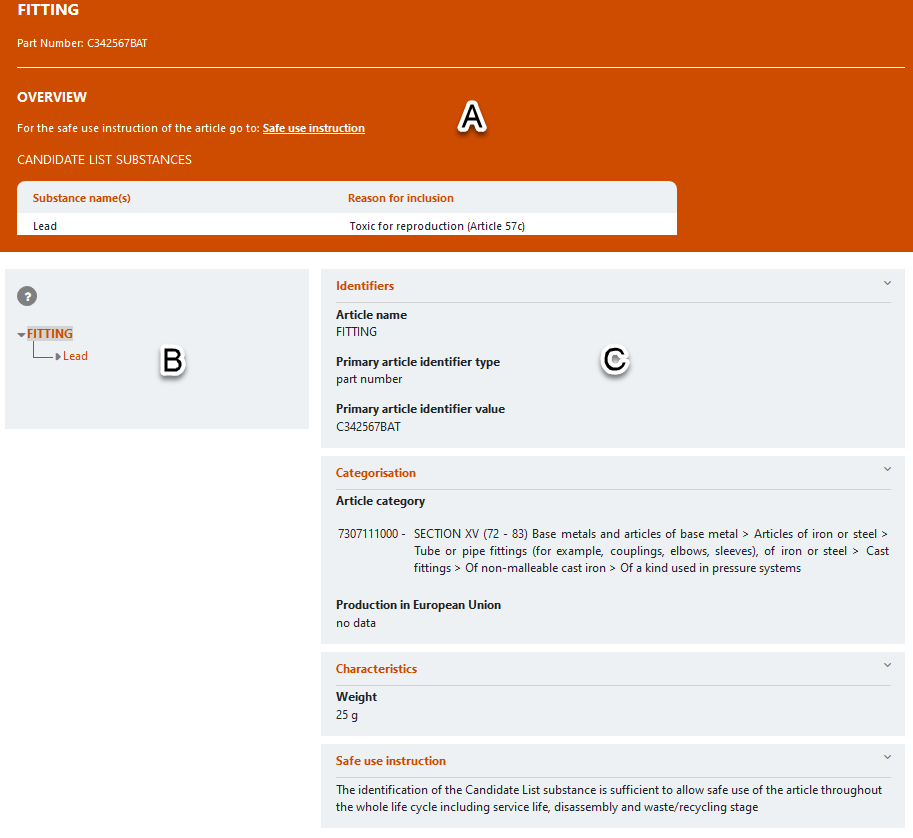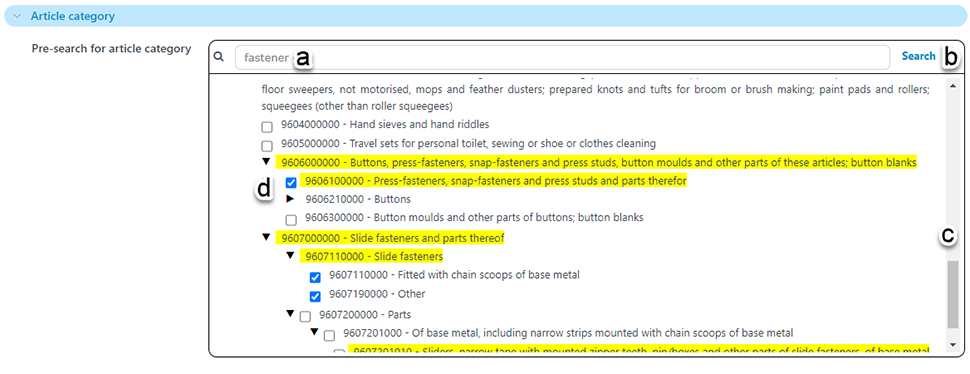Q&As
Q&As
Q&A info
Deseja procurar a pergunta e resposta relevantes na sua língua? Mude a língua no menu pendente acima.
Voltar
The revised Waste Framework Directive 2008/98/EC, which entered into force in July 2018, provided a role for ECHA to establish and maintain a database with information on substances of concern in articles, as such or in complex objects (products), named the “SCIP database”.
The SCIP database contains information on articles submitted by any EU supplier of an article with a duty to submit data according to Article 9(1)(i) of the Waste Framework Directive and Article 33(1) of the REACH Regulation.
The SCIP database provides information to identify articles containing one or more candidate list substance(s) of very high concern (SVHC) above 0.1 % (weight by weight), the location of SVHC substance(s) within an article and other information to allow the safe handling of an article, when necessary (see Q&A 1612).
The information submitted to the SCIP database is publicly available and therefore readily available to waste operators to bridge the current gap in the information flow.
The search results provide information on the latest information available from individual notifications submitted to the SCIP database. The factsheet of a notification is a snapshot in structured format of the information provided by notifiers to the SCIP database. A factsheet includes the following sections:
- An orange section (A) to provide an overview of key elements of a SCIP notification – the identifiers provided, a link to the safe use instructions, and a summary of the candidate list substances contained in the article;
- A tree structure (B) to describe the hierarchy of a complex object (article) and its components; and
- A central section (C) with identifiers, categorisation, safe use instructions and optional sections such as characteristics and number of units.

For complex object articles, components will be linked to form a hierarchy menu: all subcomponents within a hierarchy will need to be opened to identify the SVHC substance at the end of the hierarchy.

Additional information will be displayed when clicking on a component or candidate list substance header.

Notifications to the SCIP database follow a validation process that ensures that the format of SCIP notifications is correct, however the correctness of the information provided remains the sole responsibility of the data submitters.
The information published in the SCIP database is not reviewed or verified by ECHA and can be changed by the data submitter at any time without prior notice. ECHA does not guarantee the correctness of the information published in the database as it is automatically published based on notifications submitted.
A set of Q&As on general SCIP subjects can be found at: Waste Framework Directive - SCIP database
The SCIP database provides information on articles based on notifications submitted by notifiers to the SCIP database. Notifiers have two options:
- One notification corresponds to one article
- One notification corresponds to several articles. Different variations of the same article can be included in the same notification provided that the notifiers fulfil the criteria for grouping them in the same notification.
When several articles are part of one notification, it is expected that the combination of article identifier and characteristics are available to allow users of the SCIP database discern the specific article they are looking for. It is equally important that commercially available identifiers are included in a notification, whenever applicable and provided by the relevant notifier.
Additional useful information and the criteria defined for grouping can also be found in Section 3 of the guide ‘Requirements for SCIP notifications’ and Q&A 1845.
It is recommended that you follow these principles when searching in the SCIP database:
- Use commercially available standard identifiers as available in labels or catalogues, such a standard identifier, brand, or model. Be prepared to try a number of identifiers in case the one you have selected has not been included in any notification.
- When too many results are displayed, consider refining your search criteria, e.g., select a specific article category or substance of very high concern (SVHC), when already known to you.
Additional search criteria can be considered such as material & mixture category, substance of concern or reasons for inclusion (reasons for an SVHC having been added to the Candidate List (e.g., carcinogenic.)
The adequacy of the information provided to the SCIP database according to ECHA’s guidance on submission of SCIP notifications remains the responsibility of notifiers to the SCIP database.
The obligation to submit notifications to the SCIP database is applicable to all suppliers of an article within the supply chain, independently of whether an article is distributed without any further change or an article is considered as part of the assembling process. In the event that the same article is distributed within the supply chain, duplicates may be expected. Different reasons may apply, namely:
- Notifiers do not make use of the voluntary tools to refer to data already submitted e.g., SSN tool (see Q&A 1843).
- Notifiers submit their own SCIP notification before other actors in the supply chain make their notifications, so the tools to refer to data already submitted cannot be used (e.g., a supplier has not notified yet to SCIP)
- Notifiers prefer using their own standard primary article identifier to make their own notification visible in the SCIP database.
Other reasons may apply. The content of a duplicate article is expected to be the same. You may find a different (standard) primary article identifier or other information changed, depending on the reasons why a notifier decides to submit their own SCIP notification. You can consider narrowing down the search criteria using the standard primary article identifier, when available. If exact duplicates are available, it is not relevant which one is correct. In certain scenarios, different results may display the same article information but different parts numbers: this is an indication that distributors may have decided to use their own identifiers, but the article remains the same.
SCIP numbers are alphanumerical identifiers used by notifiers to the SCIP database to identify unambiguously unique SCIP notifications available in the SCIP database. Searches can now be carried out by duty holders based on exact SCIP numbers.
Please note that SCIP number searches should be done using the appropriate search filter and not the option under Article identity.

If you are searching for a SCIP number based on simplified notification (SSN) tools, it is important to consider that:
- Searches in the SCIP database cannot be made based on a notifier’s name.
- Only exact SCIP numbers can be searched for.
- If the number provided to you has been provided in error, you need to contact your supplier.
- A submission based on SSN provides notifiers the possibility to simply make reference to an already existing notification submitted to the SCIP database. Since no new content is provided in a SSN notification and the content is already available in the reference application, ECHA will publish only the content available in the reference notification.
The information required for the SCIP database must already be communicated throughout the supply chain under REACH Article 33(1). Consequently, the SCIP database complements the existing communication obligations to be considered between suppliers and downstream users. (See Q&A 1618)
Furthermore, the information published in the SCIP database is subject to confidentiality rules as described in the manual Dissemination and confidentiality in the SCIP database. In the event that additional information was needed in SCIP format, it will be the up to the supplier to provide their downstream users with the SCIP notifications (or produce IUCLID reports with or without sensitive information).
Because there are hundreds or thousands of options in the pick lists for article, material and mixture category, and likewise for substances of concern, there is a new ‘pre-search’ functionality.
In the pre-search field enter a text string of interest (a). It is important to click on the pre-search ‘search’ button (b); pressing Enter will trigger the main search for articles prematurely.
After searching for your text string of interest any matching results will be returned, highlighted in yellow as shown below (d). It is necessary that you select one or more pick-values, scrolling through the list of results (c), as necessary.

Once you have selected one or more values of interest, trigger the main search for articles to find any matching your selected criteria.

Remember to clear all previous search criteria before attempting a fresh search.
ECHA will make automatic daily updates to the information shown in the SCIP database based on data submissions. In order to successfully process the large volumes of data received some time is necessary – for validation, checking, preparing search indexes, publishing and so on. For this reason, be aware that a given submission is unlikely to be available on the public website until after a few days have passed.
The work carried out by ECHA to publish information on the SCIP database involves, among other things, the processing of large volumes of data, handling of data among different systems, synchronisation of available data based on the latest update(s) available and referential checks.
The message “data pending” in a complex object component refers to a link established by a SCIP notifier to pieces of information available in other SCIP notifications. As soon as the target SCIP notification is processed and available, the “Data pending” message will be automatically updated with the actual data that is referenced.


